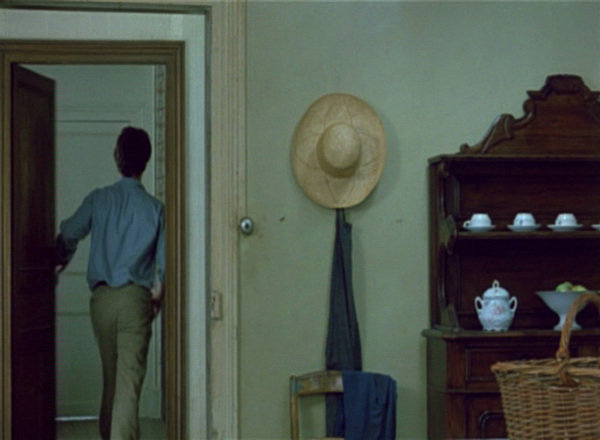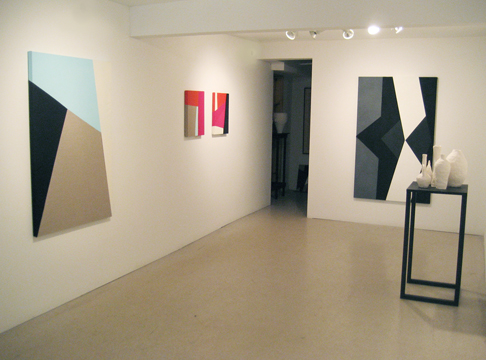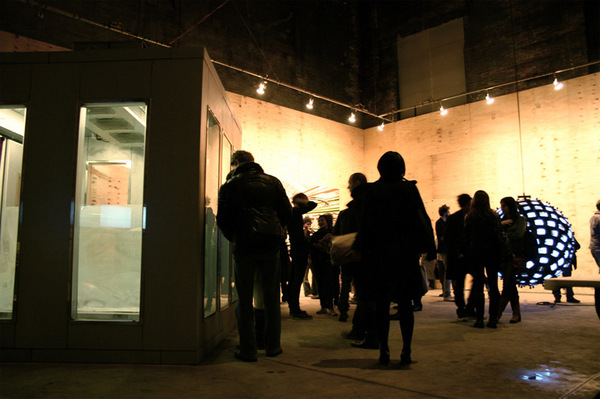This is an archive of the ArtCat Zine, 2007-2009. Please visit our new project, IDIOM.
Recently by Peter J. Russo

Blanks, Templates, Undos, Redos, Matt Sheridan Smith's debut solo exhibition at Lisa Cooley, is comprised of opaque sculptures and drawings which occupy a vague, transitional territory despite their resemblance to several ubiquitous forms in present day work-life.
The show's sole video, Untitled (open/shut), 2008 (all other works 2009) is a seven-minute montage cut from footage of actors opening and closing doors in Robert Bresson's film, L'Argent (1983). In Smith’s edit, the characters endlessly pass into and out of boutiques, cafés, homes, offices, and other spaces. Departing prompts removed, we’re given the momentary silence of a door swinging ajar, over and over again. Smith’s projection is a figural representation of his blanks, templates, undos, and redos; transitions that never lead anywhere but serve to personalize the concepts of banality operating within the other works on view.

Paintings and Pots
Sarah Crowner
Nicelle Beauchene Gallery - 165 Eldridge
26 March - 3 May 2009
Familiar New York soot thinly coated the bone-dry, paper-white surfaces of Sarah Crowner’s misshapen natura-morta rendered three-dimensional. Her decision to place five white vessel sculptures in the shoulder-high window of Nicelle Beauchene Gallery seemed particularly strange at first. However, this earnest arrangement begins a dialogue between art histories through a quiet re-contextualization of medium specificity. Paintings and Pots, the title of Crowner’s first solo exhibition, would come to seem mostly inaccurate.
Two other groupings of endearingly crude, achromatic vases also ignore carefully balanced tone and composition in the referred still-life paintings of Giorgio Morandi, forbearer to the Minimalists, setting off a kind of referential play that continues within the other works on view. Crowner’s canvases, which command the show, employ a restrained palette and bring to mind the male-dominated canon of 1950s and 60s Post-Painterly Abstraction. Though unlike those surfaces, her works divide into roughly textured linen, painted canvas, and solid-colored cloth, thereby re-introducing a handmade element to the cool touch in painting by figures such as Ellsworth Kelly. In two acute compositions, both titled Dichromatic Organization, 1959 (2009), a tension vibrates between the pictorial and physical components. The accelerating, triangular slices found in the work of Swedish painter, Olle Baertling (1911-1981, explicitly referenced in press materials) are sewn together by Crowner in a manner reminiscent of Miriam Shapiro’s (1923–) innovative fabric-and-canvas assemblages. Shapiro, a forerunner of the Pattern and Decoration Movement, began her career as a hard-edge painter.
Crowner’s canvases also piece together, and in some cases seem to pull-apart the gendered concepts of craft and high-art while joining the delimited surfaces within slick, hard-edge painting. Her use of a sewing machine evokes obvious notions of “women’s work,” while the substitution of cloth for paint returns the viewer’s gaze, checked: where one normally expects to see paint, a seemingly flat and more illusionist, yet tactile, fabric comes into focus. Crowner succeeds in historically grounding two disparate eras, but are the resulting objects a reconciliation or reclamation? How and in what ways do we distinguish art from craft, and which artists bothered to ask such questions?
Tavares Strachan
The Boiler - 191 N. 14th Street, Brooklyn NY.
7 March - 19 April 2009
A 4.5-ton block of ice clinically lit by humming fluorescents and cooled within a solar-powered freezer, Tavares Strachan’s The Distance Between What We Have and What We Want, 2004-06 went on view Saturday at The Boiler, Pierogi Gallery’s immense additional space newly opened in Williamsburg. Strachan’s project takes center stage alongside others of ambitious scale by Yoon Lee and Jonathan Schipper.
At twenty-degrees Fahrenheit, Strachan’s stolid work sits brimming with narrative—social, political, and most obviously, environmental. Trace the ice en route (via FedEx) in July of 2006, from Alaska to the Bahamas, where Strachan lived as child, fascinated by ideas of snow and ice. There, the block’s first artistic iteration materialized as an educational tool for students at Albury Sayle Primary School in Nassau. His arctic fragment served as locus for conversations on mythmaking, as well as a flag-raising ceremony and other performances. Its relocation became a gesture of globalization, dissolving boundaries between disparate climates and sovereignties, reverberating the nation’s independence from the United Kingdom thirty-three years earlier.
By converting sunlight, inimical counterpart of The Distance Between..., his frozen matter resists a kind of death by displacement in its durational performance. If, as Robert Smithson believed, “entropy contradicts the usual notion of a mechanistic world view,” Strachan contradicts entropy, creating a necessary reliance on the mechanical in doing so. Roxy Paine’s Erosion Machine, 2005 comes to mind. Yet while Paine’s glass-and-steel sandblasting machine accelerates human inscription towards unimaginable severity, Strachan’s process stabilizes the damage. The ice is a conservational case study, memorializing the environment as we know it through an earnest attempt to sustain the unsustainable.
The installation glows, flanked by twin flatscreens displaying live climatic information for Alaska and the Bahamas. Yet another video feed displays the roof-mounted solar panels; the city skyline peeks from beyond the building’s edge. Nearly forty feet overhead, fans ripple altered Bahamian flags. Strachan belabors the ice-object, as if to thoroughly demystify it through a hyper-contextualization within, to borrow Smithson’s terminology, both site and non-site. Immoderate perhaps, still, uncertainties remain. Strachan’s ice ages undetectably. Distance grows greater.
ZINE
HOME
TIPS / COMMENTS
CATEGORIES
CONTRIBUTORS
- Greg Afinogenov
- B. Blagojevic
- Adda Birnir
- Susannah Edelbaum
- Julie Fishkin
- Paddy Johnson
- Jessica Loudis
- Christopher Reiger
- Andrew Robinson
- Peter J. Russo
- Blythe Sheldon
- S.C.Squibb
- Hrag Vartanian

